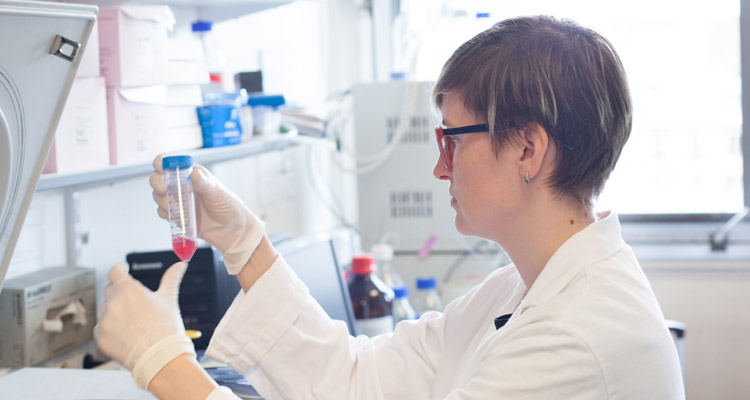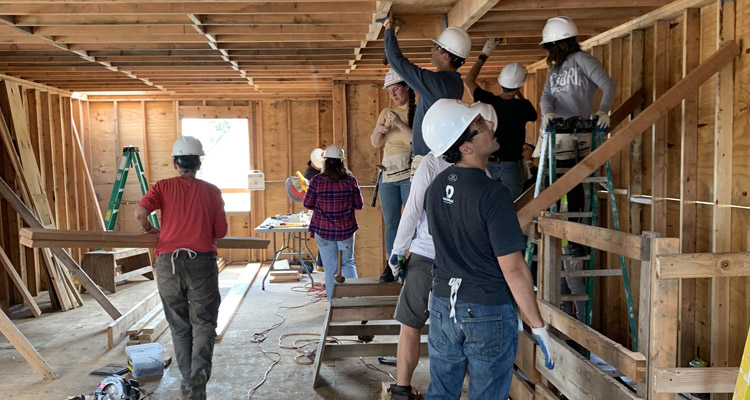The Need to Expand Buprenorphine Prescribing to Treat Opioid Use Disorder
Overdose Crisis Endures, Yet Few People Receive Existing Effective Treatment
Even before Covid-19, despite enormous unmet need, life-saving buprenorphine is vastly underprescribed
(New York, NY, August 24, 2020) –Approximately half of clinicians authorized to prescribe buprenorphine for opioid use disorder (OUD), one of three medications for OUD, are actively prescribing the medication, according to a JAMA study led by researchers at The Pew Charitable Trusts, Deerfield Management Company, and RAND Corporation.
The research letter, which appeared in the August 24th online issue of JAMA Network Open, examines national opioid use disorder buprenorphine prescribing patterns by Drug Enforcement Administration (DEA)-approved patient limits.
Buprenorphine is considered one of the most effective therapies to treat OUD. In order to become an authorized prescriber of buprenorphine to treat OUD, clinicians are required to undergo special training and licensing with the Substance Abuse and Mental Health Services Administration (SAMHSA) and DEA.
The authors of the paper point out that federal regulations currently limit these waivered clinicians to treating 30, 100, or 275 patients concurrently, with clinicians limited to treating 30 or 100 patients able to request an increased limit.
Based on a national analysis of clinician databases from the DEA and SAMHSA and clinician-level prescribing information from Symphony Health, the authors found that of 55,938 waivered clinicians, only 50.9 percent wrote at least one buprenorphine prescription during the 22-month period of April 2017 through January 2019.
Median patient monthly census calculations revealed 275-patient clinicians treated 36.9% of their patient limit, while 100-patient and 30-patient clinicians treated 23.9% and 11.3% of their patient limits, respectively.
“More than 2 million people in the United States have an opioid use disorder, yet few of them receive any type of specialty treatment, including buprenorphine,” said study co-author Alexandra Duncan, senior officer with The Pew Charitable Trusts’ substance use prevention and treatment initiative. “Removing barriers to buprenorphine prescribing can help close this treatment gap and ensure that people have access to the evidence-based addiction care they need.”
In recognition that buprenorphine is an important option for patients because it eliminates the need for the daily clinic visit required of most patients receiving methadone, NYC Health and Hospitals expanded access to the medication by integrating prescribing into primary care. Additional benefits of buprenorphine are its low potential for abuse and negligible risk for overdose.
“Our finding that about half of doctors who can prescribe buprenorphine aren’t doing so makes clear that increasing the number of patients receiving it is not just about increasing the number of clinicians who can prescribe it,” added co-author Bradley Stein, Director of RAND’s Opioid Policy Center. “We need to focus efforts on increasing reimbursement for buprenorphine’s use, educating prescribers, patients, and their families about its effectiveness, and combatting the stigma that hampers the effective treatment of opioid use disorder.”
“Leveraging multiple large databases not only allowed us to confirm earlier evidence that clinicians are prescribing below their patient limits, but also enabled us to continue to peel back the onion on the scope of this problem, said co-author Jared Anderman, director of data analytics at the Deerfield Institute, a division of Deerfield Management Company. “We are looking forward to continuing to work with the powerful dataset we have created and identifying additional opportunities to make an impact.”
Authors of the study, titled, “Monthly Patient Volumes of Buprenorphine-Waivered Clinicians in the U.S.,” are: Alexandra Duncan (The Pew Charitable Trusts); Jared Anderman (Deerfield Management Company); Travis Deseran (previously Deerfield Management Company); Ian Reynolds (The Pew Charitable Trusts); and Bradley D. Stein (RAND Corporation). The work was funded by The Pew Charitable Trusts and Deerfield Management Company.
-####-
About Deerfield Management Company
Deerfield is a healthcare investment management firm committed to advancing healthcare through investment, information and philanthropy.
Media Contacts:
Karen Heidelberger, [email protected], 212-692-7140
Warren Robak, [email protected], 310-451-6913

Deerfield Institute Report – Key insights into technology transfer offices
Translation of academic innovation has matured since the passage of the Bayh-Dole Act, 28 years ago. Universities and research institutes have contributed towards this to the tune of 380,000 disclosures, 206,000 new patent applications and 84,000 issued US patents.1 The market has responded in turn, generating 11,000 startups and 10,000 products that have yielded more than $1 billion in equity for the institutions.2 Deerfield Management has joined in this effort by entering into significant collaborations with leading academic institutions. In conjunction with these investments, the Deerfield Institute, the research division of Deerfield Management, surveyed 35 university technology transfer offices to endeavor to understand current trends impacting their organizations. The survey revealed insights that can shed light on the operations of these groups, provide guidance to those seeking to collaborate with academia and serve as a guide for continuous improvement in the practice of academic commercialization.
Deerfield Management Advanced Healthcare Initiatives Globally Through Academic Collaborations, Publications, and Philanthropy
In addition to advancing healthcare through investment, Deerfield’s efforts through information and philanthropy have an unprecedented year
New York, NY – February 6, 2019 – Deerfield Management advanced healthcare initiatives globally in 2018 through five new academic collaborations, eight scientific publications, and 22 philanthropic partnerships. Deerfield’s intent is to participate in large scale efforts to enrich patients’ lives with early stage discovery support, novel peer-reviewed insights, and investments that can help tackle the issues affecting healthcare today.
Deerfield Academic Collaborations
In 2016 Deerfield began collaborating with academic institutions to create partnerships that provide funding and support to early stage therapeutics. Since then, Deerfield has developed nine companies across eight states developing expeditious pathways from concept to commercialization for novel therapeutic discoveries and one incubator focused on innovative cardiovascular devices.
Anticipating commitments of over $500 million in early stage research by 2021, Deerfield is uniquely positioned to support all stages of development from early stage to commercial opportunity. This capability has the potential to eliminate the hurdles researchers would face in finding new capital during this rigorous trajectory to the marketplace.
Deerfield Institute
Deerfield Institute’s research capabilities and survey analyses sparked the need to begin publishing its scientific findings for the greater good. Since 2015, the Deerfield Institute has published 50 articles,editorials, and abstracts. Whether it is identifying predictors of laparoscopic hysterectomy among leiomyoma patients or exposing the variability in the therapeutic management of advanced ovarian cancer patients, the publications are weighted in scientifically driven research and analysis and leverage the knowledge interpreted by Deerfield’s team of healthcare focused researchers.
“We have a sense of responsibility to share our insights and equip our ecosystem with the high quality, novel information required to accelerate and improve healthcare,” stated Alexis Cazé, partner and chief information officer at Deerfield. “Through collaboration, we ultimately increase the greater potential of improvement in the healthcare system.”
Deerfield Foundation
Since inception the Foundation has committed or invested approximately $40 million to 39 philanthropic partners that impact healthcare for children and families from underserved communities. In 2018, the Foundation reached 11 countries with 77% of its annual funding directed towards services,goods, and outreach, 12% to infrastructure and 11% to R&D.
The Foundation has recently been exploring new models and is increasingly interested in designing granting programs with measurable impact.Whether this means pay-for-performance or key performance indicators, creating business models that lead to a self-funding business can result in self-sustaining organizations that can thrive in any philanthropic environment. “Deerfield realized the importance of exploring pay-for-performance models by pioneering our Results Based Financing for Community Health pilot,” stated Lisa McCandless from Living Goods. “Since Deerfield’s commitment, Living Goods has propelled to the forefront of this initiative globally and continues to share its learnings and findings with the broader community.”A list of our academic collaborations from 2016 to 2018 are below:
- Center for Protein Degradation with Dana-Farber Cancer Institute
- Pinnacle Hill with the University of North Carolina at Chapel Hill
- Poseidon Innovation with UC San Diego
- Lakeside Discovery with Northwestern University
- Ancora Innovation with Vanderbilt University
- Academic collaboration with Broad Institute of MIT and Harvard
- Bluefield Innovations with the Johns Hopkins University
- Bridge Medicines with Memorial Sloan Kettering Cancer Center, the Rockefeller University, and Weill Cornell Medicine
- Vescor with the University of Texas MD Anderson Cancer Center
A sample of the peer reviewed publications, reviews and abstracts published in 2018 are listed below:
- A Hybrid Approach for Prediction of Event Times in Double-Blind Clinical Trials. Ming Zhu, Yunnan Xu, Zheng Su. Joint Statistical Meeting 2018
- Predictors of laparoscopic hysterectomy for leiomyoma surgical removal in the United States. Kate Busko, Mark Stuntz. Value in Health / ISPOR
- Analysis of Success Rates for the Center for Medicare and Medicaid’s New Technology Add-On Payment Program. Alexandra Truglio, Christine Livoti. Value in Health / ISPOR
- Trends in isolated mitral valve surgery: the changing risk profile of patients and outcomes. Andrew Elbardissi, Mark Stuntz. European Society of Cardiovasculaire and Endovasculaire Surgery International Congress 2018
- The importance of emerging transcatheter mitral valve technologies in cost-effectiveness and post-procedure outcomes. Andrew Elbardissi, Mark Stuntz. European Society of Cardiovasculaire and Endovasculaire Surgery International Congress 2018
- Impact of adverse media reporting on public perceptions of the doctor-patient relationship in China: an analysis with propensity-score matching. Jing Sun, Shiyang Liu, Qiannan Liu, Zijuan Wang, JunWang, Cecile Jia Hu, Mark Stuntz, Jing Ma, Yuanli Liu. BMJ Open, August 2018
- Potential role of emerging percutaneous mitral technologies in patients undergoing TAVR. Andrew ElBardissi, Mark Stuntz. JACC, September 2018
- Futility stopping in non-inferiority trials. ZhengSu, Mark Stuntz. Contemporary Clinical Trials Communications, December 2018.
In 2018, the Deerfield Foundation invested in the following projects with its philanthropic partnerships:
- Children’s Health Fund. Deerfield Child and Family Health Clinic and New York Program,providing high quality, comprehensive and compassionate patient-centered healthcare for underserved children and families.
- Coalition for the Homeless. Child Advocate to assist homeless families in New York City.
- Covenant House. Wellness center support: medications/supplies, mental health services,and staff training on mental health and best practices.
- Jacaranda Health. Support launch of a “nurse mentor training center” to build a pipeline of public sector maternity nurse champions and improve obstetric care in Kenya.
- Last Mile Health. Continue scale-up of Liberia’s National Community Health Assistant Program, cost-effectiveness study in Grand Bassa County and launch of the Community Health Academy’s first online, free, digital training course for community health system leaders.
- Little Sisters of the Assumption Family Health Service. Environmental Health Services Program and Maternity Outreach Program.
- Living Goods. Digital optimization of business practices – enabling transformational scale for community health.
- Lwala Community Alliance. Every child: strengthening health systems to reduce maternal and child mortality.
- Many Hopes. Provide physical and mental healthcare as well as a nutritious diet for orphans and abandoned children in its rescue homes and school.
- Medic Mobile. Scaling digital health tools for improved community-level care coordination in Nepal.
- Mifanmama. Eye Care Outreach Program.
- Muso. Proactive care delivery: rigorous implementation of research to save lives and support Mali’s National Community Health Worker scale-up.
- Northside Center for Child Development. Expand Northside’s capability to treat mental health issues in children age five and under.
- Partners In Health (Zanmi Lasante). Operating costs for Zanmi Beni Children’s home.
- Possible. Designing and scaling accessible, integrated healthcare solutions for underserved communities in Nepal.
- Réseau Des Entrepreneurs Solidaires. Deerfield RES Madagascar: support approximately 31 medical centers and dispensaries run in Madagascar.
- St.Boniface Haiti Foundation. Materials and staffing for the pediatric services ward of the St. Boniface Hospital in Fond des Blancs, Haiti.
- Sustainable Health Enterprises. Initial funding of SHE28’s technological innovations to produce go! pads for girls and women.
- The Family Center. Training and certification of six clinical staff members in Parent Child Interaction Therapy.
- The Mott Haven Academy. PNP services and medical clinic support, and contributions to establish and develop adolescent health programming in its middle school.
- The Water Trust. Scaling-up the Self-Help Group Program and publishing findings to provide children in East Africa safe water and healthy homes.
- Village Health Works. Equipping the pediatric and maternity unit of the Kigutu Hospital and Women’s Health Pavilion.
About Deerfield
Deerfield is an investment management firm committed to improving healthcare through investment, information and philanthropy.
For more information, please visit www.deerfield.com
Contacts
Deerfield Management Company
Karen Heidelberger,212-551-1600
[email protected]

Stelexis Therapeutics Closes $43 million Series A to Expand Novel Platform Focused on Cancer Interception
Stelexis is a Deerfield founded and solely funded company
New York, NY – January 7, 2019 – Stelexis Therapeutics, LLC announced that it closed a $43 million Series A financing to expand its proprietary platform to discover and selectively target pre‐cancerous stem cells. Deerfield established Stelexis in 2017 together with scientific founders, Ulrich Steidl, Evripidis Gavathiotis, Amit Verma, and Roman Perez‐Soler of Albert Einstein College of Medicine, Montefiore Health, New York and Derrick Rossi of Boston Children’s Hospital, Harvard Medical School. Patrick Doyle serves as the founding CEO, and Keren Paz is the CSO of Stelexis.
Stelexis’ proprietary drug discovery platform identifies the earliest definable pre‐cancerous stem and progenitor cells that lead to the formation of human primary and recurrent tumors for therapeutic intervention and relapse prevention. Stelexis’ mission is to develop novel cancer drugs that selectively target these critical pre‐cancerous events related to both hematopoietic and solid malignancies.
“The ability to identify, isolate, study and screen rare pre‐cancerous stem cells, from within bulk tumors, is an enormous breakthrough that has the potential to change how cancer patients are treated” stated Dr. Steidl. “Our thesis is that targeting cancer at its very origin should not only be effective as first line therapy, but should also lead to long‐lasting remission for patients,” said Dr. Rossi, who, prior to co‐founding Stelexis, has also co‐founded numerous other successful biotechnology companies.
Utilizing Deerfield seed funding and operational support since 2017, Stelexis has established its labs in Albert Einstein College of Medicine facilities, hired key management and is poised to deliver clinical trial data that validate its platform using the proceeds of this Series A round.
“We are thrilled to announce the formation and funding of Stelexis, which has the platform technology to explore the role pre‐cancer conditions play in cancer development and recurrence. The team has an outstanding track record and we look forward to a stream of transformative cancer medicines,” stated Dr. Robert Jackson, director at Stelexis and partner at Deerfield Management.
“Deerfield’s holistic approach to forming, funding and providing operational support to Stelexis has been instrumental in creating a leadership position in a novel targeted approach to treating cancer,” said Patrick Doyle, CEO of Stelexis. “With these funds we are now positioned to execute on our potential to transform patients’ lives.”
About Stelexis
Stelexis is a New York‐based cancer therapeutics company, utilizing its proprietary platform to selectively target pre‐cancerous stem cells to discover and develop transformative therapies.
For more information, please visit www.stelexis.com
About Deerfield
Deerfield is an investment management firm committed to improving healthcare through investment, information and philanthropy.
For more information, please visit www.deerfield.com
Contacts
Deerfield Management Company
Karen Heidelberger
212‐551‐1600
[email protected]
Stelexis Therapeutics
Patrick Doyle
[email protected]

Deerfield and Stan Rowe Create a Next Generation Therapeutic Device Incubator, NXT Biomedical
Up to $275 million committed to the development of cutting edge technologies.
New York, NY and Irvine, CA – September 20, 2018 – Deerfield Management and Stan Rowe announce the creation of a next generation therapeutic device incubator, NXT Biomedical. NXT Biomedical expects to invest up to $25 million in cutting edge technologies over the next 5 years. Deerfield has allotted up to an additional $250 million for the formation and development of five to eight startup companies that emerge from the incubator.
NXT Biomedical will develop and advance novel therapeutic devices in diseases with significant unmet needs. Using innovative medical technology development processes, the incubator is designed to develop and de-risk technologies in a highly capital efficient manner.
Prior to cofounding NXT Biomedical, Stan Rowe was Chief Scientific Officer at Edwards Life sciences. At Edwards, Stan developed and led the Advanced Technology group, which is focused on rapid device iteration, novel research and projects to enhance the pipeline of the Edwards patient-focused innovation portfolio and discovery efforts. In his new role, Stan will continue as a consultant to Edwards.
“I am thrilled to be leading this incubator with a broad mandate for development of varying types of therapeutic devices, which brings together the expert skill sets of the founding contributors and provides an environment for creativity, innovation and professional management. I have worked with Edwards over the last several months to ensure a smooth transition from my role as CSO at the company to my next chapter leading NXT Biomedical, and I believe this collaborative effort engaging many bright and experienced innovators may spark the success of many technologies,” stated Stan Rowe, CEO of NXT Biomedical.
Stan will be joined by Robert Schwartz, MD, an interventional cardiologist who has been a prominent inventor as well, and a team of experienced engineers with unique expertise in early stage device design and development.
Andrew ElBardissi, MD, Principal at Deerfield said, “In an era of dwindling medical device early stage investment, we continue to see major unmet needs that can be optimally treated with next generation medical technologies. We are elated to join Stan and his team to develop and advance clinically meaningful devices that are poised to improve outcomes and reduce cost to the healthcare system.”
Steve Hochberg, Partner at Deerfield said, “NXT Biomedical provides an exciting new pathway for exceptional science to be incubated with the world-renowned leadership of Stan Rowe and Robert Schwartz, MD. In addition, given some of the therapeutic areas of interest to NXT Biomedical, we are also exploring potential collaborations with unnamed strategic partners. As we advance these opportunities, we are looking forward to supporting each project with financial, operational and managerial expertise.”
NXT Biomedical is based in Irvine, California at the Cove @ UCI Applied Innovation.
About Deerfield
Deerfield is an investment management firm committed to advancing healthcare through investment, information and philanthropy.
For more information, please visit www.deerfield.com
Contacts
Deerfield Management Company
Karen Heidelberger, 212-692-7140
[email protected]
A hybrid approach for prediction of event times in double-blind clinical trials
In clinical trials especially those events-driven trials, it is often of great interest to predict the timing of pre-specified landmark event accurately in order to prepare for the interim or final analyses. Both parametric and non-parametric approaches have been proposed in the literature to estimate the underlying survival functions which is the key to the prediction of future event times. However, the existing approaches are neither not applicable to double-blind clinical trials or assuming smooth survival functions which might not hold in real clinical settings. In this talk, a hybrid parametric and non-parametric approach is proposed to predict event times in double-blind clinical trials with time-to-event outcomes. A greedy algorithm is first developed to detect change points in survival functions. The survival function before the last change point is estimated non-parametrically and the tail distribution beyond the last change point is estimated parametrically. Numerical results show that the proposed approach provides accurate predictions for future event times.
Predictors of laparoscopic hysterectomy for leiomyoma surgical removal in the United States
Objectives
Leiomyomas (uterine fibroids) are benign tumors that are prevalent among women of reproductive age and affect approximately 80% of premenopausal women. Hysterectomy is one of the most common surgical procedures for removal of uterine fibroids. Laparoscopic hysterectomy (LH) has increasingly been used as an alternative to the open surgical hysterectomy (OSH). The purpose of this study was to identify predictors of LH procedures among leiomyoma patients.
Methods
The National Inpatient Sample (NIS) is the largest publicly available inpatient healthcare database in the US, containing a 20% stratified systematic random sample of all US community hospital discharges. Thirteen years of available data, 2002–2014, were used for this analysis. International Classification of Diseases 9th revision (ICD-9) codes were used to identify all records of women with primary discharge diagnosis of uterine leiomyoma who had undergone either LH or OSH. Multivariate logistic regression analysis was conducted to identify significant predictors of LH. Population sampling weights were used to extrapolate results to national estimates.
Results
There were 310,150 leiomyoma LH procedures from 2002 to 2014, corresponding to 22.5% of the total number of leiomyoma hysterectomy procedures. The mean age of patients undergoing LH was significantly higher than those undergoing OSH (45.69 years vs 43.29 years; p<0.001). After adjusting for covariates, significant predictors of LH procedures included age > 50 years (OR=3.18; 95% CI=3.57-4.07), hospital location in the West (OR=1.46; 95% CI=1.38-1.86), and hospital urban non-teaching status (OR=1.20; 95% CI=1.04-1.38).
Conclusions
The study shows that despite the advances in surgical technologies, there are very few predictors of non-conventional laparoscopic approach to leiomyoma hysterectomy. Our findings suggest that there is a differential access to LH procedures among the US population which may be, in part, a result of racial and socioeconomic differences and centralization of laparoscopy services in urban areas.

Analysis of success rates for the Center for Medicare and Medicaid’s new technology add-on payment program
Objectives
To quantify the approval, denial, and withdrawal rates and identify any predictors of success or failure for all new technology add-on payment (NTAP) applications from FY 2003 to FY 2018 in the United States.
Methods
The Center for Medicare and Medicaid (CMS) releases inpatient payment methodology rulemaking annually in the Federal Register, including details of NTAP submissions. The proposed and final rulemaking documents were analyzed to quantify the approval, denial, and withdrawal rates of all applications and determine primary reasons for denial or withdrawal from FY 2003 to FY 2018. Raw data were coded to further examine any predictors of application success such as product type, therapeutic category, manufacturer type, reapplication status, and proposed rule determination.
Results
There were 95 NTAP applications submitted over the last 15 fiscal years. Approximately 30%, 25%, and 45% of applications were approved, withdrawn prior to final rule, or denied, respectively. Inability to meet the “newness criteria” developed by CMS was the primary reason for denied and withdrawn applications. Product type, therapeutic category, and reapplication status have minor to significant impact on the approval rate of an application. However, manufacturer type and proposed rule determination have little to no impact on application outcome.
Conclusions
While there are a few factors that may positively influence the outcome of a NTAP application, the approval rates for the program are low overall. Without additional reimbursement from the NTAP program, inpatient hospitals may be deterred from adopting innovative therapies because of financial burdens. CMS and manufacturers should strive to find a better consensus for a framework that adequately incentivizes the utilization of new technologies for Medicare beneficiaries.
The importance of emerging transcatheter mitral valve technologies in cost-effectiveness and post-procedure outcomes
Abstract 00165: Mitral intervention has historically been open surgical and has been limited to a small subset of patients who could tolerate surgery and where there was perceived clinical benefit. With the emergence of transcatheter mitral interventions, we sought to compare the types of patients undergoing surgical and transcatheter mitral interventions. Moreover, we sought to determine if there were any major differences in adverse events, length of stay (LOS), and cost to the healthcare system










